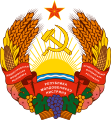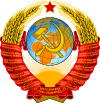Emblems of the Soviet Republics
The table below presents final versions of the renderings of the Soviet republics' emblems prior to the dissolution of the USSR in 1991, as well as the arms of two republics that ceased to exist before that time. For comparison, national arms of present-day successor states of the Soviet republics are also shown. As can be seen, most Central Asian post-Soviet republics use arms based on or reminiscent of the Soviet-era emblems, with Tajikistan and Uzbekistan have present-day arms nearly identical to the Soviet one. Most European republics, on the other hand, reverted to their traditional pre-Soviet heraldic arms. Belarus used the traditional Pahonia as its coat of arms from 1991 to 1995 when it was replaced by a new emblem closely resembling the Soviet-era design.
| Republic | Emblem | Main article | Republic-specific features | Present-day national coat of arms | |
|---|---|---|---|---|---|
| Russian SFSR |  | Emblem of the Russian SFSR | Plants | wheat | 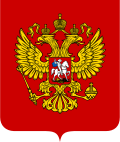 Coat of arms of Russia |
| Landscapes, geographic features | |||||
| Industry | |||||
| Ornaments | Baroque cartouche | ||||
| Ukraine |  | Emblem of the Ukrainian SSR [1] | Plants | wheat | 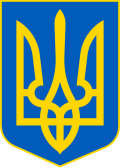 Coat of arms of Ukraine |
| Landscapes, geographic features | |||||
| Industry | |||||
| Ornaments | Baroque cartouche | ||||
| Byelorussia |  | Emblem of the Byelorussian SSR | Plants | wheat, clover, flax |  Emblem of Belarus |
| Landscapes, geographic features | |||||
| Industry | |||||
| Ornaments | |||||
| Uzbekistan |  | Emblem of the Uzbek SSR [1] | Plants | wheat, cotton |  Emblem of Uzbekistan |
| Landscapes, geographic features | |||||
| Industry | |||||
| Ornaments | |||||
| Kazakhstan |  | Emblem of the Kazakh SSR [2] | Plant | wheat |  Emblem of Kazakhstan |
| Landscapes, geographic features | |||||
| Industry | |||||
| Ornaments | |||||
| Georgia |  | Emblem of the Georgian SSR | Plants | wheat, grapes |  Coat of arms of Georgia |
| Landscapes, geographic features | Caucasus Mountains | ||||
| Industry | |||||
| Ornaments | Georgian ornament with a seven-pointed star from the pre-1921 Georgian coat of arms | ||||
| Azerbaijan |  | Emblem of the Azerbaijan SSR [3] | Plants | wheat, cotton |  Emblem of Azerbaijan |
| Landscapes, geographic features | Sun rising on Caspian Sea | ||||
| Industry | oil drilling rig | ||||
| Ornaments | |||||
| Lithuania |  | Emblem of the Lithuanian SSR [1] | Plants | wheat, oak |  Coat of arms of Lithuania |
| Landscapes, geographic features | |||||
| Industry | |||||
| Ornaments | |||||
| Moldavia | 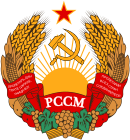 | Emblem of the Moldavian SSR [1] | Plants | wheat, maize, pears, grapes |  Coat of arms of Moldova |
| Landscapes, geographic features | |||||
| Industry | |||||
| Ornaments | |||||
| Latvia |  | Emblem of the Latvian SSR | Plants | wheat |  Coat of arms of Latvia |
| Landscapes, geographic features | Baltic Sea | ||||
| Industry | |||||
| Ornaments | |||||
| Kirghizia |  | Emblem of the Kirghiz SSR | Plants | wheat, cotton | 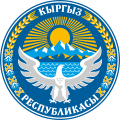 Emblem of Kyrgyzstan |
| Landscapes, geographic features | Tian Shan Mountains | ||||
| Industry | |||||
| Ornaments | Kyrgyz embroidery | ||||
| Tajikistan |  | Emblem of the Tajik SSR [1] | Plants | wheat, cotton | 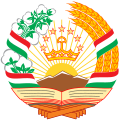 Emblem of Tajikistan |
| Landscapes, geographic features | |||||
| Industry | |||||
| Ornaments | |||||
| Armenia |  | Emblem of the Armenian SSR | Plants | wheat, grapes |  Coat of arms of Armenia |
| Landscapes, geographic features | Mount Ararat [4] | ||||
| Industry | |||||
| Ornaments | |||||
| Turkmenia |  | Emblem of the Turkmen SSR | Plants | wheat, cotton, grapes |  Emblem of Turkmenistan |
| Landscapes, geographic features | Turkmen landscape | ||||
| Industry | oil drilling rig | ||||
| Ornaments | gillam detail from a Turkmen rug | ||||
| Estonia |  | Emblem of the Estonian SSR [5] | Plants | rye, pine, spruce |  Coat of arms of Estonia |
| Landscapes, geographic features | |||||
| Industry | |||||
| Ornaments | |||||
| Republics that dissolved before 1991 | |||||
| Karelo-Finnish SSR (1940–1956) |  | Coat of arms of the Karelo-Finnish SSR | Plants | rye, pine |  Coat of arms of Karelia (constituent entity of Russia) |
| Landscapes, geographic features | Karelian landscape | ||||
| Industry | |||||
| Ornaments | Karelian embroidery | ||||
| Transcaucasian SFSR (1922–1936) |  | Emblem of the Transcaucasian SFSR | Plants | Wheat, cotton, maize, rice, grapes | |
| Landscapes, geographic features | Caucasus mountains | ||||
| Industry | Factory, oil drilling rigs | ||||
| Ornaments | |||||
